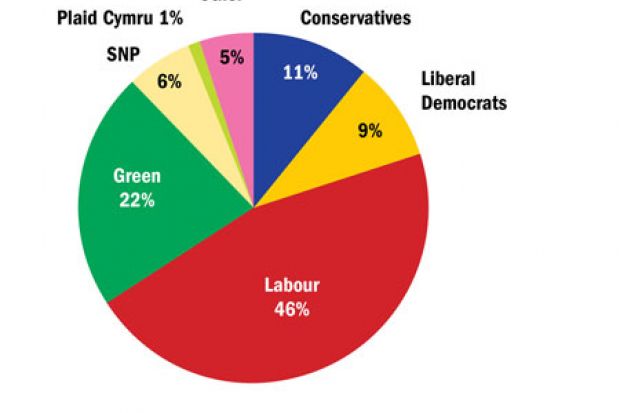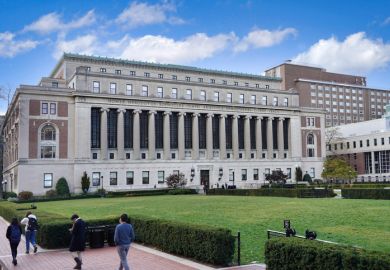We need a government that supports universities in attracting and welcoming the best and brightest students and staff from all around the world
Survey respondent
Nearly half of UK higher education staff plan to vote Labour in the coming general election, while a fifth say they will vote Green, a survey by Times Higher Education suggests.
The online survey, which gained 1,019 responses, also shows that just one in 10 plans to vote Conservative. Only four respondents said that they planned to back Ukip.
Votes from university seats could prove key in a number of constituencies, including Sheffield Hallam, where Nick Clegg, the leader of the Liberal Democrats, is trying to fight off a Labour challenge.
Philip Cowley, professor of parliamentary government at the University of Nottingham and co-author of The British General Election of 2010, said that “people always get the issue of university seats wrong”.
He continued that “students often don’t vote in great numbers – and even when they do, they often don’t vote in their university constituency. University seats are much more about those who work in or around the university, and who do live and vote there – with academics, and their families, being a core part of that.”
Overall, the THE survey – which carries the caveat of being self-selecting – found that 46 per cent of staff plan to vote Labour, followed by Green (22 per cent), Tory (11 per cent), Lib Dem (9 per cent) and Scottish National Party (6 per cent).
They are all as bad as each other; they are just willy-waving about who can be toughest on foreigners, who can tax the least or bribe the most
Survey respondent
Nationally, the survey showed that Labour’s level of support among professional or support staff (48 per cent) was even higher than it was among academics (45 per cent). But Tory support was also stronger among such workers (15 per cent) than among academics (8 per cent).
The late A. H. Halsey, who was emeritus professor of social and administrative studies at the University of Oxford, provided some data on the political views of academics in his 1995 work Decline of Donnish Dominion. Surveys that he conducted found that support for the Tories among non-Oxbridge university academics fell from 38 per cent in 1964 to 19 per cent in 1989. Professor Halsey observed “a strengthening of anti-Conservative feeling in the British academic professions” over this period.
Tim Bale, professor of politics at Queen Mary University of London and author of The Conservative Party: From Thatcher to Cameron (2010), said that “academics, like teachers and all sorts of other public sector professionals, deserted the Tories in their droves during the Eighties and Nineties as tight spending settlements badly impacted on higher education and other parts of the welfare state”.
He added: “This problem was compounded by the populist, anti-immigration, Eurosceptic, law and order direction the party hared off in after 1997: there is a clear correlation between levels of education and liberal and internationalist attitudes on such issues. In other words, the ‘nasty party’ was always likely to be seen as even nastier by those in higher education than by the electorate as a whole.”
Top-end fees should be higher than £9K, more like private schools. They should go into a ring-fenced pot and be part of the redistribution of public money to universities
Survey respondent
Nick Hillman, director of the Higher Education Policy Institute and Tory candidate in Cambridge in 2010, suggested that the political views of those in universities might “reflect a different outlook on life, perhaps shaped by spending time in strong institutions that, at least on paper, care about things other than money and that offer a sort of mutually supportive environment in which to work.
“On the other hand,” he continued, “one might worry that the results suggest that many academics, who are usually spurred on by independent thought, hunt as pack animals when it comes to the ballot box.”
Asked which funding policy they thought would best serve higher education, 48 per cent of respondents opted for abolishing tuition fees and replacing them with direct public funding. That was followed by a graduate tax (21 per cent). Just 4 per cent said that uncapped fees were the best option.
Additional work on survey by Chris Parr
Voting intentions by disciplinary area: business bombshell, angry blob and creative isolation

If the Conservatives struggle for support in UK universities generally, you might expect business and law to be one area where they score well.
But even though the party registered more support in that field than in any other disciplinary area, just 19 per cent of academics in business and law said that they would be voting Tory.
The Times Higher Education survey asked respondents, if they were academics, to state which of eight broad disciplinary areas they teach or research.
The low point for the Conservatives was creative arts, where no academic intended to vote Tory. The Labour vote was highest among education academics, where the party had 52 per cent support, suggesting that “The Blob” – as Michael Gove, the former Tory education secretary, once characterised education researchers – may be intent on revenge. Labour’s lowest ebbs were at 40 per cent among academics in business and law, and in biological and physical sciences/mathematics.
The high point for the Greens was in creative arts, where they had 43 per cent support.
Scotland: strong support for sturgeon’s SNP
The Scottish National Party will win the votes of half of higher education staff north of the border and put Labour into retreat in universities if the results of the Times Higher Educationsurvey are any indication.
The survey gained 111 responses from staff who said that they would be voting in Scotland. Although a small sample, it showed that 53 per cent planned to vote SNP, followed by Labour (21 per cent), Green (16 per cent), Liberal Democrat (5 per cent) and Conservative (4 per cent).
The tallies for the SNP and Labour would be broadly in line with surveys of the wider population in Scotland, where a YouGov poll for The Times published on 21 April had the parties on 49 per cent and 25 per cent respectively.
Among the small number of respondents to the THE survey working at the University of Edinburgh, the SNP (48 per cent) was ahead of Labour (20 per cent). At the University of Glasgow, the tally was SNP 70 per cent, Labour 15 per cent.
John Morgan
Register to continue
Why register?
- Registration is free and only takes a moment
- Once registered, you can read 3 articles a month
- Sign up for our newsletter
Subscribe
Or subscribe for unlimited access to:
- Unlimited access to news, views, insights & reviews
- Digital editions
- Digital access to THE’s university and college rankings analysis
Already registered or a current subscriber? Login





